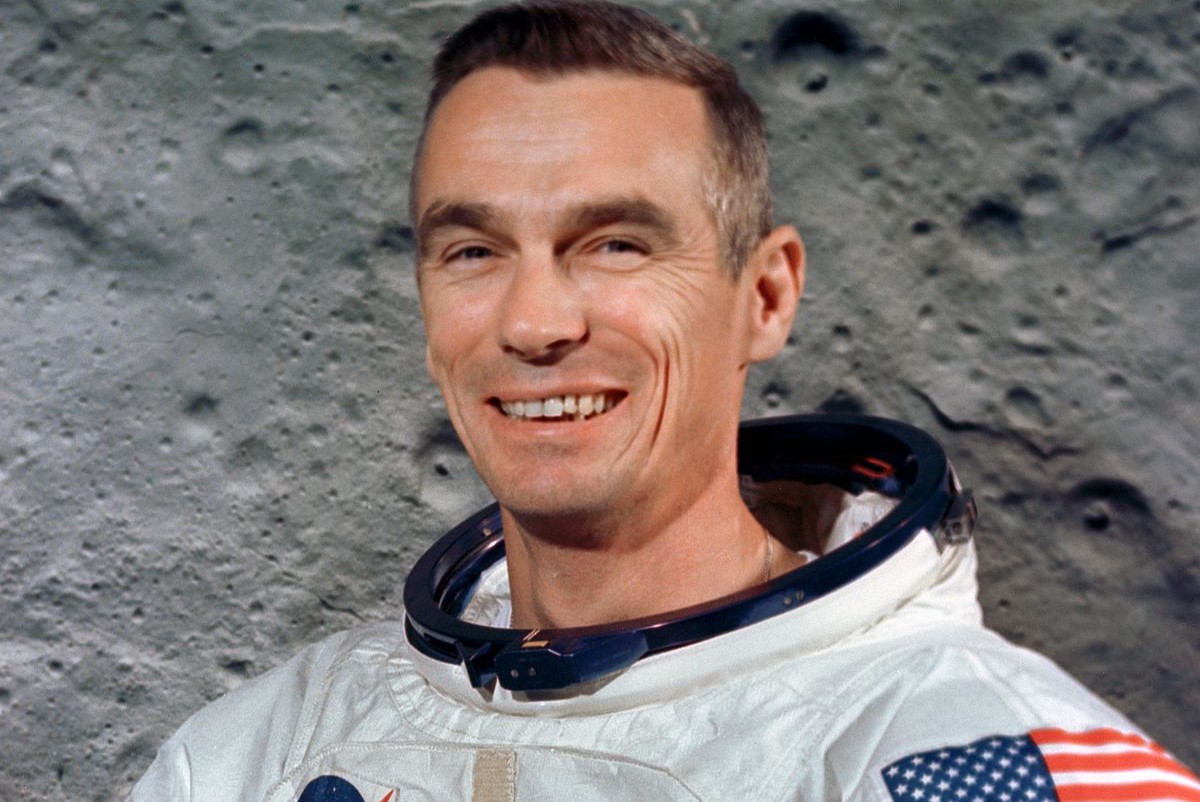
Eugene Cernan, known as the last man to have walked on the moon, was an extraordinary figure in the world of space exploration. With a career spanning over two decades, Cernan made valuable contributions to NASA’s Apollo program and left an indelible mark on the history of human spaceflight.
In this article, we will delve into 20 extraordinary facts about Eugene Cernan, shedding light on his remarkable achievements, his pioneering spirit, and his influence on future space missions. From his early days as a Navy pilot to his iconic lunar footsteps, Cernan’s journey was one of perseverance, bravery, and a deep love for exploring the unknown.
Join us as we uncover fascinating details about Cernan’s life and career, highlighting his significant contributions to space exploration and honoring his lasting legacy as a true pioneer of the final frontier.
Key Takeaways:
- Eugene Cernan was the last person to walk on the moon, leaving his footprints as a reminder of humanity’s achievements in space exploration and inspiring future generations to dream big and reach for the stars.
- With over 566 hours in space, Cernan’s legacy as a pioneering astronaut and advocate for science education continues to captivate the world, showcasing the boundless human spirit and our enduring quest to push the boundaries of what we can achieve.
Eugene Cernan was the last person to walk on the moon.
On December 14, 1972, Cernan became the twelfth and final astronaut to step foot on the lunar surface during the Apollo 17 mission. His historic moonwalk lasted over seven hours.
Cernan was born on March 14, 1934, in Chicago, Illinois.
Hailing from the Windy City, Eugene Cernan grew up with a passion for space exploration and aerial adventures. This drive ultimately led him to become a renowned astronaut.
He was of Czech and Slovak descent.
Cernan’s heritage traced back to Czech and Slovak roots, adding a rich cultural background to his remarkable journey as an astronaut.
Cernan flew three NASA space missions.
Throughout his career, Eugene Cernan participated in three space missions: Gemini 9A in 1966, Apollo 10 in 1969, and Apollo 17 in 1972.
He holds the record for the longest time spent in lunar orbit.
During the Apollo 10 mission, Cernan and his crewmate, Thomas Stafford, orbited the moon for a total of 60 lunar orbits, setting a new record at the time.
Cernan and Harrison Schmitt were the last two people to ascend from the lunar surface.
With Cernan being the last to step foot on the moon, Harrison Schmitt, his fellow astronaut on the Apollo 17 mission, holds the distinction of being the penultimate person to leave the moon.
He logged over 566 hours in space.
During his three space missions combined, Cernan spent a staggering 566 hours and 15 minutes in space, solidifying his place in history as a highly accomplished astronaut.
Cernan was awarded the NASA Distinguished Service Medal.
In recognition of his exceptional contributions to space exploration, Eugene Cernan received the NASA Distinguished Service Medal, one of the agency’s highest honors.
He retired from NASA in 1976.
After an illustrious career as an astronaut, Cernan retired from NASA and pursued various business ventures while continuing to advocate for space exploration.
Cernan made a cameo appearance in the film “The Last Man on the Moon.”
In 2014, a documentary film titled “The Last Man on the Moon” was released, showcasing Cernan’s life and accomplishments. He appeared in the film, sharing his experiences and reflecting on his time as an astronaut.
He was the commander of Apollo 10.
As the commander of the Apollo 10 mission, Cernan played a pivotal role in preparing for the subsequent Apollo 11 moon landing, performing crucial tests and gathering vital data.
Cernan once said, “Dream the impossible and go out and make it happen. I walked on the moon. What can’t you do?”
Known for his inspiring words, Cernan encouraged others to pursue their dreams and push the boundaries of what is possible, drawing inspiration from his own extraordinary journey to the moon.
He authored the book “The Last Man on the Moon: Astronaut Eugene Cernan and America’s Race in Space.”
In his memoir, Cernan shared his personal experiences as an astronaut and shed light on the intense competition between the United States and the Soviet Union during the Space Race.
Cernan was also a Navy aviator.
Before joining NASA, Cernan served as a Navy aviator, accumulating important flying experience that would later aid him in his space missions.
He was inducted into the U.S. Astronaut Hall of Fame in 1993.
Recognizing his significant contributions to space exploration, Eugene Cernan was inducted into the U.S. Astronaut Hall of Fame, joining the ranks of other legendary astronauts.
Cernan’s spacesuit is displayed at the Smithsonian National Air and Space Museum in Washington, D.C.
The spacesuit worn by Cernan during his Apollo 17 mission is now an iconic artifact on display at the Smithsonian National Air and Space Museum, captivating visitors with its historical significance.
He was a strong advocate for science education.
Eugene Cernan recognized the importance of inspiring future generations to pursue careers in science and space exploration, actively promoting science education initiatives and programs.
Cernan received the Navy Distinguished Flying Cross for his service during the Korean War.
Prior to his career as an astronaut, Cernan served in the United States Navy during the Korean War and was awarded the Navy Distinguished Flying Cross for his exceptional service.
He passed away on January 16, 2017, in Houston, Texas.
After a remarkable life dedicated to space exploration, Eugene Cernan sadly passed away in Houston, leaving behind a legacy that continues to inspire future generations.
Cernan’s footprints still remain on the lunar surface.
As the last person to walk on the moon, Eugene Cernan’s footprints are a lasting reminder of humanity’s achievements in space exploration and our ongoing quest to explore the unknown.
These 20 extraordinary facts about Eugene Cernan highlight his remarkable contributions to space exploration and showcase the indelible mark he left on history. From being the last person to walk on the moon to his inspiring words and advocacy for science education, Cernan’s legacy continues to inspire and captivate the world. His accomplishments serve as a reminder of the boundless human spirit and our enduring quest to push the boundaries of what we can achieve.
Conclusion
In conclusion, Eugene Cernan was an extraordinary individual who left an indelible mark on space exploration. From being the last man to step foot on the moon to setting numerous records during his career, Cernan’s contributions to the field are truly remarkable. His passion, dedication, and commitment to pushing the boundaries of human exploration serve as an inspiration to us all. Beyond his accomplishments in outer space, Cernan also had a profound impact on raising awareness about the importance of preserving Earth’s environment. His legacy lives on through the many milestones he achieved and the admiration he garnered from people around the world. Eugene Cernan will forever be remembered as a trailblazer and a true hero of our time.
FAQs
1. How many times did Eugene Cernan go to space?
Eugene Cernan went to space three times during his career. He flew on Gemini 9A, Apollo 10, and Apollo 17.
2. What records did Eugene Cernan set during his career?
Cernan set several records throughout his career, including being the second American to walk in space and the last human to leave his footprints on the moon.
3. What was Eugene Cernan’s role in the Apollo 10 mission?
Cernan served as the Lunar Module Pilot on the Apollo 10 mission. This mission was a rehearsal for the actual moon landing and included crucial tests of the lunar module in lunar orbit.
4. What was Eugene Cernan’s contribution to preserving Earth’s environment?
After retiring from NASA, Cernan became an advocate for environmental preservation. He actively worked to raise awareness about the fragility of our planet and the importance of taking action to protect it.
5. Why is Eugene Cernan considered a hero?
Cernan is considered a hero for his bravery, exploration of the unknown, and his dedication to pushing the boundaries of space exploration. His achievements have inspired generations and his impact on scientific progress is immeasurable.
Eugene Cernan's extraordinary life inspires us to reach for stars. His legacy as a naval aviator, contributions to space exploration, and status as one of America's most celebrated astronauts make him a true hero. Discover more incredible stories about John McCain's service, mankind's greatest space exploration achievements, and fascinating astronaut facts that will leave you in awe of these brave pioneers who pushed boundaries of what's possible.
Was this page helpful?
Our commitment to delivering trustworthy and engaging content is at the heart of what we do. Each fact on our site is contributed by real users like you, bringing a wealth of diverse insights and information. To ensure the highest standards of accuracy and reliability, our dedicated editors meticulously review each submission. This process guarantees that the facts we share are not only fascinating but also credible. Trust in our commitment to quality and authenticity as you explore and learn with us.


